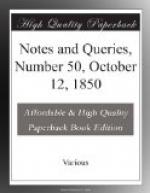This air has double claims on our attention, as its existence, in any shape, is placed amongst the “doubtful” points by the following note extracted from the Rev. J. Hunter’s New Illustrations of Shakspeare, vol. i. p. 268.:—
“Concolinel. In the absence of any thing like sufficient explanation or justification of this word, if word it is, I will venture to suggest the possibility that it is a corruption of a stage direction, Cantat Ital., for Cantat Italice; meaning that here Moth sings an Italian song. It is quite evident, from what Armado says, when the song was ended, ‘Sweet air!’ that a song of some sort was sung, and one which Shakespeare was pleased with, and meant to praise. If Moth’s song had been an English song, it would have been found in its place as the other songs are.”
I, for one, cannot subscribe to Mr. Hunter’s suggestion that our great poet intended an Italian song to be sung in his play and for this reason, that Italian music for a single voice was almost unknown in this country in 1597, at which date we know Love’s Labour’s Lost was in existence. Surely Concolinel is just as likely to be the burden of a song as Calen o Custure me, mentioned in Henry the Fifth (Act iv. sc. 4.), of which there is now no doubt.
I may just mention, in passing, that I have discovered the air of Calen o Custure me in a manuscript that once belonged to Queen Elizabeth, and have ample proof that it was an especial favourite with her maiden majesty. The commentators were at fault when they pointed out the more modern tune of the same name in Playford’s Musical Companion, 1667.
EDWARD F. RIMBAULT.
S. Augustus Square, Regent’s Park.
Andrewes’s Tortura Torti (Vol. ii., p. 295.).—On what forms Mr. Bliss’s third quotation, which does appear in some shape in Bernard, De Consid. ad Eugen., iii. 4. 18., the Bibliotheca Juridica, &c., of Ferraris observes, under the head of Dispensatio: “Hinc dispensatio sine justa causa non dispensatio sed dissipatio dicitur communiter a doctoribus, ut observant et tenent Sperell;” then referring to several Romish canonists, &c., the last being Reiffenstuel, lib. i., Decretal, tit. 2., n. 450., of which I give the full reference, his volumes being accessible in the British Museum, if not elsewhere.
NOVUS.
Swords worn in Public (Vol. ii., p. 218.)—A very respected and old friend of mine, now deceased, used to relate that he had often seen the celebrated Wilkes, of political notoriety, walking in the public streets, dressed in what is usually termed court dress, wearing his sword. Wilkes died in 1797. In connexion with this subject it may be interesting to your readers to know that in 1701 it was found necessary to prohibit footmen wearing swords. An order was issued by the Earl Marshal in that year, declaring that—




